Recent Storm Damage Posts
Ice Storms
1/17/2025 (Permalink)
Ice storms are caused by freezing rain, which occurs when raindrops fall from a warm layer of air into air that is below freezing and become supercooled. When the supercooled drops hit a surface that’s below 0º, they freeze instantly and form a layer of ice. While those glistening, ice-coated trees might look beautiful from the comfort of your heated home, ice storms can lead to widespread power outages and cause serious damage to homes, trees, and power lines. Learn more about how to prepare your home and life to stay safe from damages once an ice storm rolls through town.
Before an Ice Storm Hits The heavy build-up of ice can break tree branches, down power lines, and damage homes and cars. Other dangers include hypothermia, fires and carbon monoxide poisoning, which can occur from people using alternative heating sources during periods of extended power failures. If an ice storm warning has been issued, prepare yourself before it arrives. Make sure you have emergency supplies for you and your family to last at least 72 hours. You should also do the following: Turn your refrigerator and freezer to their coldest settings. Listen to the radio or TV for weather advisories and warnings. Fill up your car’s gas tank. Prepare an emergency supply kit with basic supplies including food, water, a flashlight, battery-operated radio and extra batteries.
What to Do After an Ice Storm After the storm has passed, you might be tempted to get out of the house to salt your sidewalks or go to the store to restock your supplies. Consider these tips before leaving the house after an ice storm: Watch out for falling ice, branches, and power lines. Even hours after the freezing rain has stopped, ice, branches, and power lines can continue to break and fall down. Avoid walking or driving under trees or anything else that could be coated with ice and stay away from downed power lines. Check for a buildup of ice on your roof. Ice dams can do serious damage to your home, and they shouldn’t be ignored. If you notice a buildup of ice or snow on your roof, consider hiring a professional to safely remove it.
Calling the Pros When Ice Storm Damage Occurs If you spot downed power lines or tree branches nearby when you’re inspecting your property and the immediate surroundings for damage, it’s best to not go near them at all. If the ice cracks part of your infrastructure and melts, it could lead to extensive water damage on your property that will need to be remediated immediately to keep mold from growing. If you have encountered this scenario or something similar, make sure to call SERVPRO Morgantown for an immediate consultation
Tracie "Dusty" Nichols
Emergency Kit for Evacuation for the Deaf, Blind, and Service Animal
7/12/2024 (Permalink)
Emergency Kit for Evacuation for the Deaf, Blind, and Service Animals in Morgantown.
Storm Damage & Evacuation in Morgantown. Low vision or hearing loss may make a power outage more difficult in Morgantown. Evacuation may also be more difficult.
SERVPRO of Morgantown has these tips:
- Have an evacuation emergency kit ready. You can also use it at home.
- For people who have low hearing or deafness in Morgantown, consider the following:
- Extra batteries for hearing aids
- If you Sign, have a pen and paper for people who do not know Sign
- Backup batteries for any augmentative communication devices
For people who have low vision or blindness in Morgantown, consider the following:
- Use large-print or Braille on labels Magnifiers or other assistive devices
- White cane (if you use one)
- Storm damage makes life more difficult for service animals too.
For people who have service animals in Morgantown, consider the following:
- Food, water, and other supplies
- Tell emergency responders that your service animal travels with you
- Shelters and other buildings may not refuse entry to a service animal
Links: https://www.ready.gov/individuals-access-functional-needs
Tracie "Dusty" Nichols
304-291-3434
Roof Damage
5/2/2024 (Permalink)
In any type of weather there are lots of different issues that could cause damage to your home; Roof damage is one of those.
Damage due to storms is the most typical, but there are several things that COULD cause the damage to your roof some being more visible than others.
It is always good practice to have your roof inspected every 10-12 years, unless there has been a specific issue that may have caused a reason to check it sooner such as a severe storm, hail, or some other sort of natural disaster. Unfortunately, when your roof becomes damaged it can lead to bigger issues that may ultimately cause water damage to the interior of your home.
Here we mention a few things to look for when you are inspecting your roof:
- Loose or missing shingles: this could be caused by high winds, improper installation, or simply wearing out over exposure to the elements through the years. Loose nails can also leave a hole in the shingle that water can find its way through as well.
- Poor installation of the flashing. "Flashing" is the metal that is placed in the sections where the roof meets the walls, or in the valleys. This must be installed properly to divert water from the roof.
- Gutters that are not placed with the right pitch, or that have seams that are not sealed properly can also cause water to back up and then overflow into the house causing water damage to ceilings and/or walls. Not having gutter guards to keep leaves and debris from collecting in the gutters can cause overflow of water that can result in damage to your roof and other areas of your home as well.
- Rotted fascia or soffit can also be an area -that allows water to intrude.
If you suspect that you may have roof damage causing water damage to your home please feel free to contact us at and we will be happy to assist you. SERVPRO® of Morgantown can also supply emergency tarping and board up if the need may arise. SERVPRO® of Morgantown will be there for all of your home repairs or accidents.
Tracie "Dusty" Nichols
304-291-3434
Do You Need A Power Surge?
1/26/2024 (Permalink)
A power surge is an unwanted and unexpected surge of voltage that can damage or destroy your electronic equipment. Most people think of lightning and/or storms as the source of power surges however, the National Electrical Manufacturers Association estimates over 60% of surges originate from inside the home.
A surge protector will protect your smaller, more expensive electronics. Some surge protectors include outlets for ethernet, cable, or satellite connections. Surge protectors are relatively easy to use. You simply plug them into the device you wish to protect. Only the electronics plugged into the device will be protected. Most surge protectors look like a power strip. Be sure to determine you are using an actual surge protector and not a power strip. The surge protector limits the unexpected voltage supplied to the electronic device by blocking those voltages that are above a safe level. If a surge does happen, and your electronics were protected, you will need to replace the surge protector after the event. You will also need to replace your surge protectors over time to ensure they will work properly when needed. While surge protectors offer a great deal of protection, no surge protector can handle a direct lightning strike.
There are many threats to your home, both inside and out. SERVPRO of Morgantown strives to educate home and business owners on protecting their most valuable assets.
Tracie "Dusty" Nichols
304-291-3434
Weather Damage To Your Home.
7/7/2023 (Permalink)
In any type of weather there are lots of different issues that could cause damage to your home;
Roof damage is one of those. Damage due to storms is the most typical, but there are several things that COULD cause the damage to your roof some being more visible than others.
It is always good practice to have your roof inspected every 10-12 years, unless there has been a specific issue that may have caused a reason to check it sooner such as a severe storm, hail, or some other sort of natural disaster. Unfortunately, when your roof becomes damaged it can lead to bigger issues that may ultimately cause water damage to the interior of your home. Here we mention a few things to look for when you are inspecting your roof: Loose or missing shingles: this could be caused by high winds, improper installation, or simply wearing out over exposure to the elements through the years. Loose nails can also leave a hole in the shingle that water can find its way through as well.
Poor installation of the flashing. "Flashing" is the metal that is placed in the sections where the roof meets the walls, or in the valleys. This must be installed properly to divert water from the roof.
Gutters that are not placed with the right pitch, or that have seams that are not sealed properly can also cause water to back up and then overflow into the house causing water damage to ceilings and/or walls. Not having gutter guards to keep leaves and debris from collecting in the gutters can cause overflow of water that can result in damage to your roof and other areas of your home as well.
Rotted fascia or soffit can also be an area that allows water to intrude.
If you suspect that you may have roof damage causing water damage to your home please feel free to contact us at and we will be happy to assist you. SERVPRO® of Morgantown can also supply emergency tarping and board up if the need may arise. SERVPRO® of y will be there for all of your home repairs or accidents.
Tracie "Dusty" Nichols
304-291-3434
Property Damage from Storms
5/12/2023 (Permalink)
As we head into the summer months, West Virginia storms may be on their way, which can cause damage to your home. While we have experienced a dry spring, you never know when a sudden storm could form in our area. Below are some different ways a storm can cause property damage.
Roof Damage
- High winds and water are the perfect combination to damage your roof. Whether it is tearing off shingles or opening a crack that creates a leak, your roof is the first and foremost concern after a violent storm. Additionally, trees and branches could be brought down during the storm, causing obviously devastating damage.
Siding
- Similar to your roof, wind and rain can tear siding off your home or create leaks. After a storm, walk around the perimeter of your home and make sure nothing has come loose or been torn off.
Foundation Damage
- While you may not think about your foundation being damaged in a storm, a storm with a large volume of rain can cause flooding into your basement. Rain can sink down and pool up next to your foundation, increasing the pressure of water against your foundation wall, which could result in cracks, shifting, sinking, and bowed foundation walls.
These are just a few ways that storms can damage your home. If you ever have damage that you want professionally inspected, give us a call and we will see what we can do to help you get your home back to normal.
Tracie "Dusty" Nichols
309-291-3434
Frostbite Signs and Symptoms
12/7/2022 (Permalink)
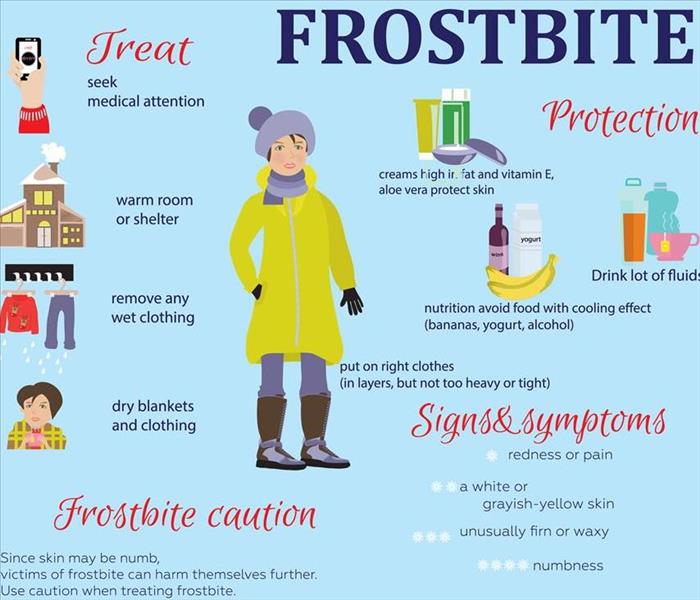 Frostbite Signs and Symptoms
Frostbite Signs and Symptoms
Frostbite Symptoms Have you ever been exposed to freezing weather conditions and noticed your skin becoming very cold and red, and after that numb, hard, and pale? If you have, then you have experienced the first signs of frostbite! SERVPRO® of Morgantown responds to storm damage emergencies in and other cities in , and we want you to stay safe and healthy this winter season.
Here is some information on frostbite and when to see a doctor from the Mayo Clinic:
Signs and symptoms of frostbite include: At first, cold skin and a prickling feeling Numbness
Red, white, bluish-white or grayish-yellow skin Hard or waxy-looking skin
Clumsiness due to joint and muscle stiffness
Blistering after rewarming, in severe cases
Seek medical attention for frostbite if you experience: Signs and symptoms of superficial or deep frostbite
Increased pain, swelling, redness or discharge in the area that was frostbitten
Fever
New, unexplained symptoms
Get emergency medical help if you suspect hypothermia, a condition in which your body loses heat faster than it can be produced. Signs and symptoms of hypothermia include:
- Intense shivering
- Slurred speech
- Drowsiness and loss of coordination
Call Us!
When your home or business has a storm damage emergency, SERVPRO® of Morgantown has a team of storm restoration technicians on call to serve you 24-hours a day. Call us at 304-291-3434. We’ll restore your storm damage in Morgantown, “Like it never even happened.
SERVPRO of Morgantown is Independently Owned and Operated.
Tracie "Dusty" Nichols
304-291-3434
Preparing for Seasonal Storms
7/29/2022 (Permalink)
 Preparing for Seasonal Storms
Preparing for Seasonal Storms
Here in Morgantown, we are no strangers to the seasonal storms that affect our area. Whether it be hurricanes, flooding, snowstorms, or freezes it is important to be prepared for whatever may come. Part of being prepared is knowing what to do when the storm has passed.
If you find yourself being affected by a storm event in the area, call SERVPRO of Morgantown immediately. Time is of the essence in these types of situations, so it is important to act as quickly as possible so we can start making your storm damage, "Like it never even happened."
How You Can Start Preparing Now:
- Know Our Area's Risk Heavy rainfall, high winds, flooding, snowstorms and freezes are weather related things our area needs to be aware and cautious of.
- Stock Up on The Necessities It is not uncommon for these larger storms to lead to power outages. Make sure you are stocked up on water, food, batteries for flashlights, and anything else you may need to feel more comfortable during a power outage. Keeping your cell phones fully charged as the storm nears is also smart; being able to contact family, friends, and first responders is always important!
- Stay Informed Keep an eye on our local news and weather alerts, for information regarding the storm.
- Staying alert for flash flood warnings and strong wind advisories can help keep you and your family safe throughout the storm.
- Have a Backup Plan If your home is in an area prone to flash flooding, have a backup plan!
Call relatives and friends and make a plan to visit a home in a safer location during the storm! For more information on emergency preparedness, visit ready.gov.
Tracie "Dusty" Nichols
304-291-3434
Droughts Cause Damage Too!
6/24/2022 (Permalink)
We normally associate storm damage to flooding, high winds, and hail. What we forget, is that no storms can create issues for you and your property, too!
On the other end of the scale if you don’t have rain or water for days, weeks, or months, then your community can go into a drought. The main effects of drought are actually something you would never think of - flooding.
When a drought occurs all of the moisture dries up causing clay heavy soil to shrink. This means the foundation that your home is built on begins to shift and crack from the changing movement. In turn, your foundation is not able to withstand the force of the movement and may start to crack under pressure. These cracks are silent and won’t affect you during the drought. Only until the drought is over and your area begins to bring rain will you discover the cracks to your foundation. From there water can enter your home causing the cracks to erode and make bigger openings. From there you can have moisture entering your home causing mold and even worse full blown flood.
Tracie "Dusty" Nichols
304-291-3434
Do you know the difference between a tornado WATCH and a tornado WARNING?
5/20/2022 (Permalink)
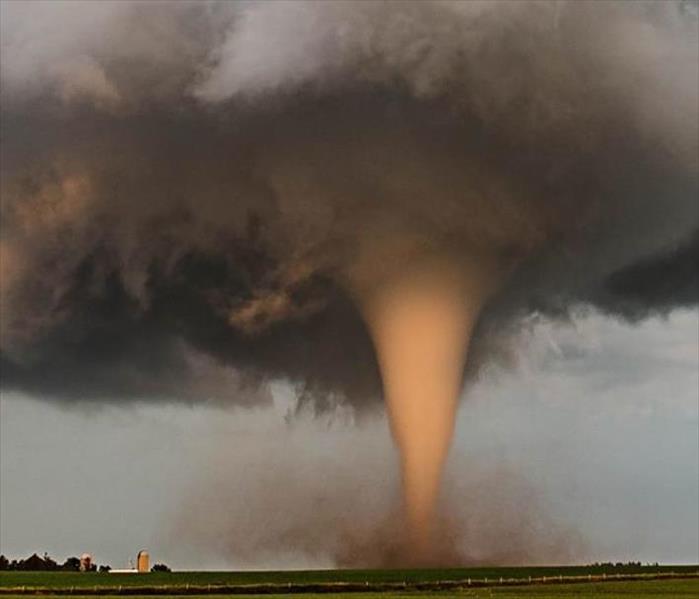 Do you know the difference between a tornado WATCH and a tornado WARNING?
Do you know the difference between a tornado WATCH and a tornado WARNING?
Do you know the difference between a tornado WATCH and a tornado WARNING?
Tornadoes are nature’s most violent storms. They start out as powerful thunderstorms and build up into funnel-shaped clouds that reach from the thunderstorm to the ground. These whirling winds can reach up to 300 miles per hour and have the capability to destroy everything in its path. Tornadoes develop quickly and there may be little to no advanced warning before one hits your area. The best thing to do is know the basics and be sure to plan ahead.
A tornado WATCH is the term used to identify that the weather conditions are favorable for a tornado. This is a time to stay alert and prepare for a possible tornado. When experiencing a tornado WARNING, that means a tornado has been spotted and there is a serious threat to life and property to those in its path. This is a time to act and find shelter. Everyone should have a way to receive a tornado warning even while sleeping.
Emergency alerts can sound an alarm on your smartphone when a warning is issued for your area. When a warning is issued, it is best to seek shelter in a small interior room of a sturdy building; a basement, closet, hallway or a windowless bathroom.
Knowing the difference between the two can prepare you for the necessary steps to take when considering the threat of severe weather.
Tracie "Dusty" Nichols
304-291-3434
Reasons Not To Drive Through Flood Waters
5/11/2022 (Permalink)
3 Reasons Not To Drive Through Flood Water
The temptation to drive through flood water can be difficult to resist. Perhaps you are eager to get home to deal with your flooded basement, or maybe you just don’t want to take the time to go around. Driving down a flooded street can be dangerous, so consider letting a professional storm damage restoration service clean up your basement, while you review these three reasons not to drive through floodwater:
1. You could damage your vehicle. Most cars only have a few inches of ground clearance and even a large truck or SUV may not have more than a couple of feet. Flood water can damage the engine, electrical system and interior of your vehicle. Additionally, flooded roads may have potholes, debris and other obstacles concealed by standing water.
2. You could lose control of your vehicle. As little as six inches of standing water on a flooded street can cause you to lose traction, skid off the road and cause an accident. 12 inches of water can cause most cars to float. A floating vehicle won’t respond to your attempts to steer or brake, which could lead to an accident, or even cause your vehicle to be washed away. Floodwaters can also stall engines. A car with no working engine can not be driven out of floodwater or maneuvered to avoid potential collisions.
3. You could drown. A vehicle that is stalled or washed away by floodwaters can fill with water and cause drowning or be washed into a river or creek. The people who may attempt to rescue you from your flooded vehicle are also at risk of drowning. In almost all cases, the risks of driving down a flooded street outweigh any time or inconvenience you might save by not taking a detour.
If there is a potential for flood conditions in the forecast the travel tips may help you successfully navigate areas at high risk for flooding
Tracie "Dusty" Nichols
304-291-3434
Hail Can Be Harmful And Cause Damage
3/11/2022 (Permalink)
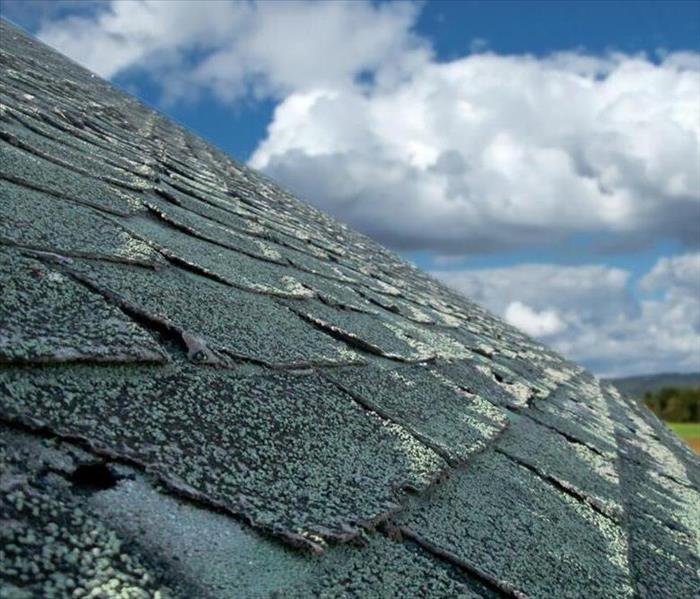 Hail Can Be Harmful And Cause Damage
Hail Can Be Harmful And Cause Damage
When the ravages of nature take a toll, causing roof damage, it can be upsetting.. Rain, sleet, snow load, wind can all cause problems and leaks, but the topic here is the potentially destructive force of hail.
Types of Damage Caused by Hail:
- Hail does not just occur at any one specific season, but can happen year round. When it comes to your roof, the damage is recognizable if you know what you are looking for. Here are some guidelines that may help.
- Impact indentations have no distinct edge, where installation dents likely have an edge from a hammer.
- Broken or cracked shingles can be a sign of hail damage if there are several and they are scattered across the roof, particularly the tile or terra cotta type.
- Spatter marks that look like something hit and then skidded.
- Missing shingles or those that look like the surface was broken away on impact.
Reasons Hail is Harmful:
Storm damage from hail can shorten the life of your roof. Keeping the roofing surface in good shape can help minimize damage. Make sure all shingles are nailed down and flashings are sealed at the edges to reduce roof damage. Secure rain gutter to prevent it coming down. Hail damage can cause leaks or even flood damage inside your building. Insulation can become soaked and the extra weight can cause sections of the ceiling to cave in.
Getting Help:
In many cases, property insurance will help with the cost of repairs, providing that the roof has been well maintained. A professional water damage restoration company in Morgantown can help with storm cleanup. Water removal and mold abatement are key to completing a sound restoration and making your building safe again. Inspect for roof damage following every hail event to ensure problems are taken care of in a timely manner. If serious problems occur requiring flood cleanup, get the help you need.
Tracie "Dusty" Nichols
304-291-3434
Pet Safety During the Winter Months
1/5/2022 (Permalink)
Pet Safety During the Winter
At SERVPRO of Morgantown, we know that your pets are an important part of your family. Most pets are indoor animals, but it is a common sight to see pets outdoors also.
Animals are prone to the same winter hazards as human beings, especially cold and ice. Here are some tips for keeping your family pet safe.
- Limit outdoor time on bitter cold days.
- Try to go out when the sun is shining.
- Even with fur, animals can become too cold and go into hypothermia.
- Avoid the ice. Animals can slip and fall just like you.
- More importantly, animals cannot recognize the danger of breaking through thin ice on frozen water.
- It is always better to keep your pet on a leash during the winter to help them steer clear of hazards.
- Wipe their paws when you come inside. Things in front of your home are often treated with salt or other de-icers. These substances can irritate your animal's paws. Some can be toxic, which is especially dangerous if your pet licks its paws.
People and pets want a safe place inside for the cold months. If a winter emergency like a burst pipe makes your home unsafe, contact SERVPRO of Morgantown. We are here to help the residents of Morgantown quickly get their homes back to normal.
Tracie "Dusty" Nichols
304-291-3434
Failed Sump Pumps
10/13/2021 (Permalink)
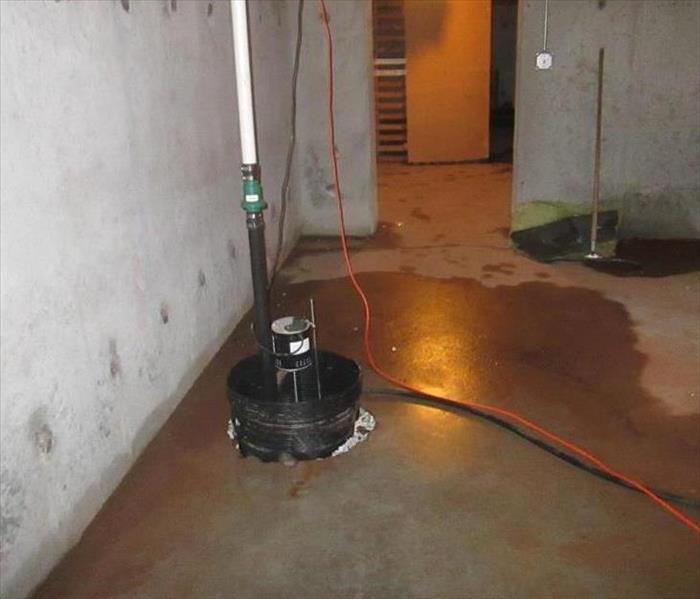 Failed Sump Pumps
Failed Sump Pumps
If you have a sump pump, most of the time you don't realize how important it is until it stops working.
Power outages, failure and a sump pump that cannot handle the capacity are common problems. Avoid potential problems by doing routine inspections or replacing your old sump pump. Usually sump pumps should be replaced about 5 years or according to manufacturer's guidelines and each year the sump, switch and float should be inspected as well.
Pay attention to how often the sump pump is running and if it runs regularly or there is a higher water table, consider a sump pump with higher horsepower. Another way to increase the pump's efficiency and prolong its life is to clean your sump pit, remove any dirt, sand, gravel and other debris routinely. Ensure that the discharge line opening is free of obstructions so that water can be pumped through the line and out of your basement or crawlspace and also be aware in the winter the discharge line may freeze bringing the water back into your house.
Regular checks can make sure you don't ever get surprised by your sump pump!
Tracie "Dusty" Nichols
304-291-3434
Three Reasons Not To Drive Through Flood Water
7/9/2021 (Permalink)
3 Reasons Not To Drive Through Flood Water
The temptation to drive through flood water can be difficult to resist. Perhaps you are eager to get home to deal with your flooded basement, or maybe you just don’t want to take the time to go around. Driving down a flooded street can be dangerous, so consider letting a professional storm damage restoration service clean up your basement, while you review these three reasons not to drive through floodwater:
1. You could damage your vehicle. Most cars only have a few inches of ground clearance and even a large truck or SUV may not have more than a couple of feet. Flood water can damage the engine, electrical system and interior of your vehicle. Additionally, flooded roads may have potholes, debris and other obstacles concealed by standing water.
2. You could lose control of your vehicle. As little as six inches of standing water on a flooded street can cause you to lose traction, skid off the road and cause an accident. 12 inches of water can cause most cars to float. A floating vehicle won’t respond to your attempts to steer or brake, which could lead to an accident, or even cause your vehicle to be washed away. Floodwaters can also stall engines. A car with no working engine can not be driven out of floodwater or maneuvered to avoid potential collisions.
3. You could drown. A vehicle that is stalled or washed away by floodwaters can fill with water and cause drowning or be washed into a river or creek. The people who may attempt to rescue you from your flooded vehicle are also at risk of drowning.
In almost all cases, the risks of driving down a flooded street outweigh any time or inconvenience you might save by not taking a detour. If there is a potential for flood conditions in the forecast the travel tips may help you successfully navigate areas at high risk for flooding.
Tracie "Dusty" Nichols
304-291-3434
Different Types of Storm Damage
5/21/2021 (Permalink)
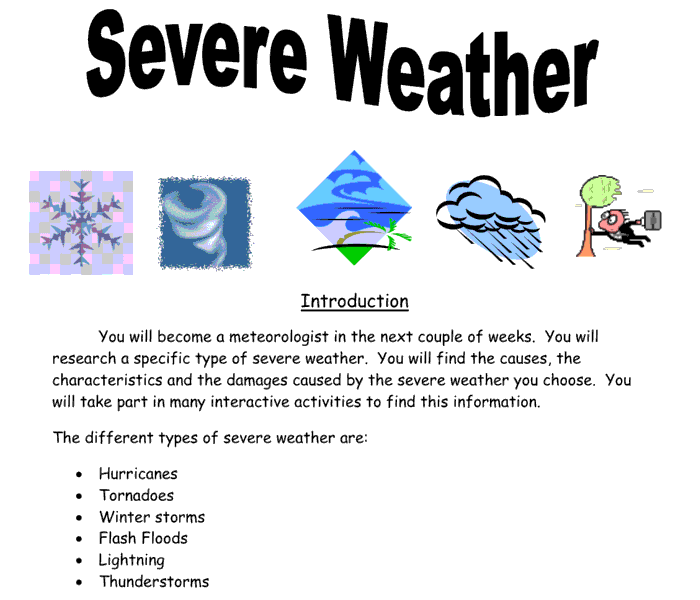 Different Types of Storm Damage
Different Types of Storm Damage
Did you know there are different types of storms?
SERVPRO of Morgantown will share some examples
- Storm Related Water Damage - This category of storm damage includes flooding events like tropical storms, flash floods, tornadoes, and hurricanes or Pretty much any storm related event that causes water to intrude into your home or business. This type of damage often happens as a result of or alongside several of the other common types of storm damage.
- Wind Damage - High winds can cause significant damage to roofs, trees, vehicles and windows.
- Hail Damage - dents in shingles, vents and cars
- Lightening Damage - can spark fires
- Winter Storms - Freezing Rain, snow which can cause roof collapse, ice dams and pipe burst.
Regardless of the type of storm damage that you may experience, SERVPRO of Morgantown is available to walk you through the necessary steps needed to restore your home or business.
Tracie "Dusty" Nichols
304-291-3434
Experiencing Hail Damage?
5/11/2021 (Permalink)
Ever Experienced Hail Damage?!
When someone says that there is a storm on the way, keep in mind that there are all kinds of different storms. All kinds of different storms can produce damage to your home or business.
Some storms that occur produce hail.
- Hail can be the size of a pea or the size of a soft ball. Hail can do a lot of damage to your property. It can put small or large dents in your vehicles, and out door furniture.
- Large hail can also damage damage your roof and siding of your home. Hail has also been known to bust a window.
Here at SERVPRO of Morgantown, we know how devastating any type of damage can be so if you find your self in the situation that you have had damage to your home or business because of a hail storm, give SERVPRO of Morgantown a call.
Tracie "Dusty" Nichols.
Considering a Storm Door?
5/8/2021 (Permalink)
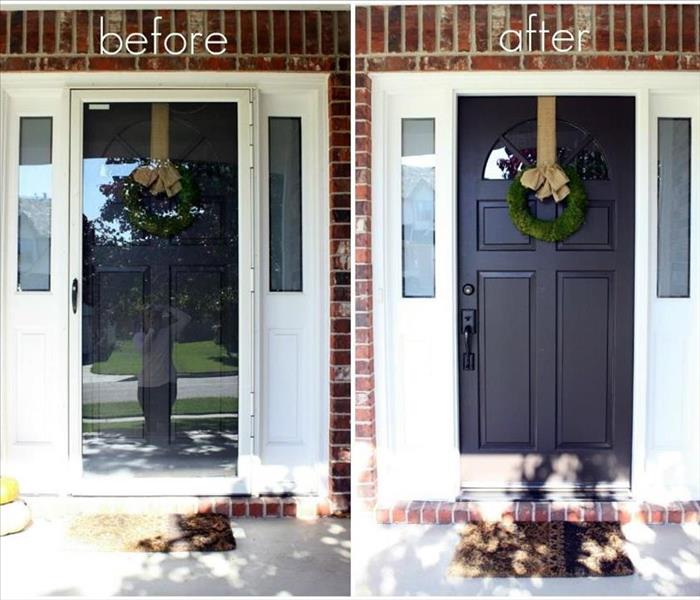 Considering a Storm Door?
Considering a Storm Door?
If your home's front door is durable and sturdy, a storm door may seem unnecessary. However, there are more benefits to a storm door, such as added protection against intrusion and energy efficiency. Here are some advantages that will help you decide if having a storm door is for you.
1. Noise Minimization: Noise travels the air through molecule vibrations. Recording studios use doubled doors that contain thick material to slow down the vibration of air, therefore reducing noise entry into a room. Similarly, storm doors introduce a noise reducing effect, turning your home into a quiet getaway.
2. Energy Efficiency: The first principle of insulation is that the seal of the barrier should have no gap, therefore not allowing temperature-regulated air to escape, and unregulated air to enter. A storm door can help improve insulation by adding barriers to your entryway, which is the most susceptible part of your home.
3. Security: Storm doors generally come with a bolt-and-padlock feature, advanced security vault locks or strengthen screens and reinforced fiberglass. These features add security to the home, compared to a regular door.
4. Style: The entrance door of your home is the first thing people see. If you are looking to make a good impression, storm doors can be crafted with elegance and according to your specifications using materials such as wood, plexiglass, aluminum, and PVC.
5. Affordability: Replacing any door in your home is not cheap. You will have to buy a prefabricated door, or the materials to make one and hire a professional contractor to install it. A beautifully designed storm door can be a better solution than simply replacing it with another regular door since it is more durable and reliable.
6. Ventilation: Storm doors are versatile and generally have screen and fiberglass windows, allowing to switch between them, to get air flow, or maintain indoor temperatures.
7. Value: Storm doors are durable and affordable. They can be made from wood, aluminum or other sturdy materials. They are made to last and can be a great investment because they will add value to your home if you decide to sell it in the future.
If you have a questions, give us a call today.
304-291-3434
Tracie (Dusty) Nichols
Dangers of Winter Storms
1/3/2021 (Permalink)
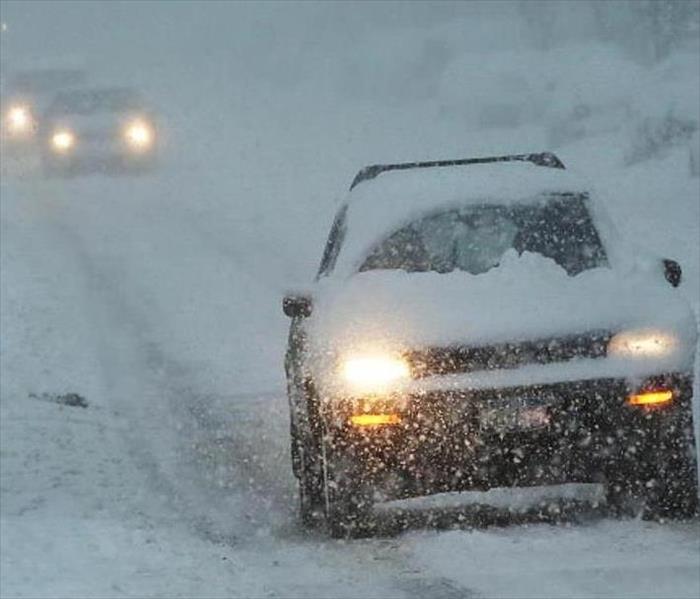 Winter Storms.
Winter Storms.
Does your area get affected by winter storms?
Has a winter storm been devastating to you or your family?
Winter storms can be a disaster for your home or business. We are here to help you avoid water damage or fire damage. SERVPRO of Morgantown is here to educate the community of the best practices that you should use. A major winter storm can be lethal. You should prepare for the cold weather conditions and respond to them effectively so you can reduce the dangers caused by winter storms.
Before the storm hits:
- You should watch and be familiar with winter storm warning messages. (See Winter Storm Watches and Warnings.)
- Make sure you service any snow removal equipment, have rock salt on hand to melt ice on walkways, and you can use kitty litter to generate temporary traction.
- Make sure you have sufficient heating fuel and make sure regular fuel sources may be cut off.
- You should also winterize your home. Here are some tips to do so: Insulate walls and attic, Caulk and weather-strip doors and windows, and Install storm windows or cover windows with plastic from the inside.
- In case you do not have. have safe emergency heating equipment available. Examples :Fireplace with ample supply of wood, Small, well-vented, wood, coal, or camp stove with fuel, and Portable space heaters or kerosene heaters.
- You should always install and check smoke detectors.
- Another tip is that you can contact your Parish Emergency Management Office or American Red Cross chapter for more information on winter storms.
When storms hit, it is a good idea to do some things to help keep pipes from freezing:
- Wrap pipes in insulation or layers of old newspapers, Cover the newspapers with plastic to keep out moisture,
- Let faucets drip a little to avoid freezing, and Know how to shut off water valves.
- Lastly, you should have disaster supplies on hand, in case the power goes out.
Some things to keep around:
- Flashlight and extra batteries, Portable, battery-operated radio and extra batteries, First aid kit, One-week supply of food (include items that do not require refrigeration or cooking in case the power is shut off), Non Electric can opener, One-week supply of essential prescription medications, Extra blankets and sleeping bags, and Fire extinguisher (A-B-C type).
Any questions, you can also call us!
Tracie "Dusty" Nichols
304-291-3434
Can thunderstorms be Dangerous?
12/9/2020 (Permalink)
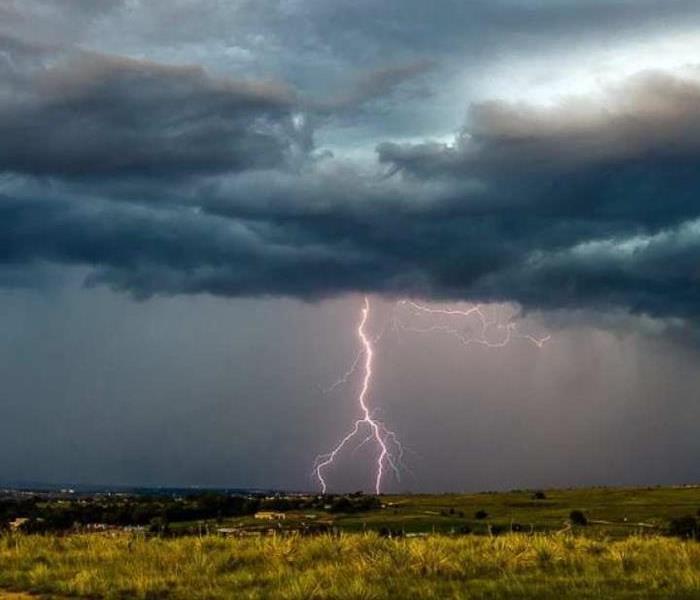 Thunderstorm in action.
Thunderstorm in action.
Can thunderstorms be Dangerous?
The answer is YES!
Thunderstorms can be one of the more dramatic weather events and they can make themselves known through the crashes and bright bolts of lightning. Here is how storms can cause damage to your home so you can be aware of what to watch out for.
There are several ways that a thunderstorm can lead to issues around the house. Some main ways can be lightning damage, flood damage and the development of water leaks that are in your home. Knowing what can happen is the best way to keep yourself and your home safe/ damage-free.
Three main things can happen when a thunderstorm rolls through your area.
1. Lightning Damage: Some thunderstorms are caused by electrical charges in the air, this produces the lightning and thunder we can see and hear. While many lightning bolts will strike from cloud to cloud, the ones that strike the ground can cause serious damage to buildings/homes. Lightning that strikes on or near a home can send an electrical current through the wiring, which can lead to surges to electronics and even electrical fires within the walls of your home or business.
2. Flood Damage: Floods can be caused for many reasons, but flash floods are caused by sudden, heavy rainfall that overwhelms an area, and they can cause serious damage to the area. Flash floods are a big concern after thunderstorms because they can overwhelm any area and multiple areas. They can catch people off guard, so it is important to always be listening about the weather because flash flooding is a possibility. While the physical damage can cause devastation, the flash floods can also be very dangerous.
3. Water Leaks: Leaks in the house are extremely common after heavy rain, as the moisture can work its way into the home that homeowners were not aware of. You should check your roof after every big storm to look for missing shingles or any indicator that there is a leak underneath. Also check around all windows and doors to ensure their seals have held up and be sure there is no water in your gutters or around your foundation to help with flooding and water damage.
For any questions call SERVPRO of Morgantown
Tracie "Dusty" Nichols
304-291-3434
Winter Storm Prevention
12/9/2020 (Permalink)
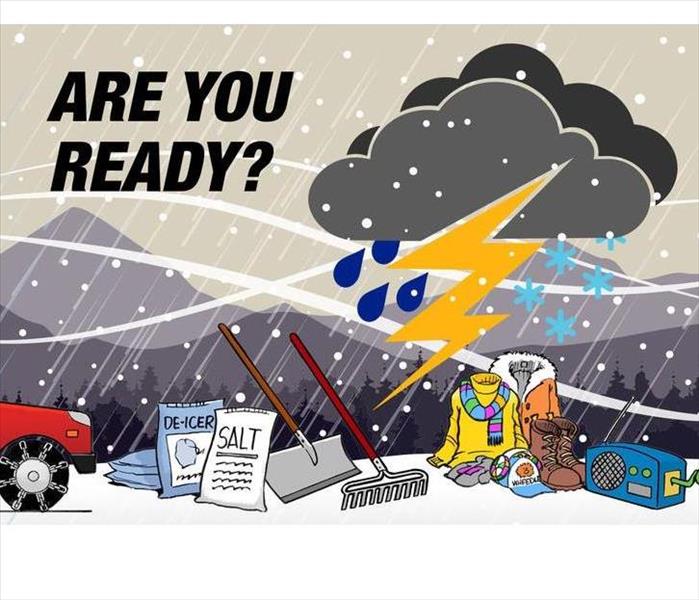 Are you Ready?
Are you Ready?
Now that it is winter and snow is underway, SERVPRO of Morgantown wants to give you some tips on how to help you prepare for winter storms.
Winter storms and how to prepare your home:
- Installation is a big key and needs to be done correctly.
- Install some storm windows or use plastic for windows.
- Consider safe heating techniques to help with fires/ fire damage.
- Look into ways to help pipes from freezing to help with future pipe bursts.
- If located in rural areas, think about snow fences to help with snow drifts.
- In the spring think about ways to help your home with some flood damage techniques when the snow is time to thaw.
If you have any questions or concerns with anything give us a call today!
Tracie "Dusty" Nichols
304-291-3434
"Like it never even happened."
Hail Damage
5/21/2020 (Permalink)
When someone says that there is a storm on the way, keep in mind that there are all kinds of different storms. Some storms produce hail. Hail can be the size of a pea or the size of a soft ball. Hail can do a lot of damage to your property. It can put small or large dents in your vehicles, and out door furniture. Large hail can also damage damage your roof and siding of your home. Hail has also been known to bust a window. If you find your self in the situation that you have had damage to your home because of a hail storm, give SERVPRO of Morgantown a call.
"Like it never even happened."
SERVPRO of Morgantown, WV
Tracie "Dusty" Nichols
304-291-3434
Roof Damage
5/11/2020 (Permalink)
When storms come threw, they can cause a lot of damage to your home or business. Strong winds and heavy rains can cause damage to your roof. It can blow shingles off of your roof causing your roof to leak. Once your roof starts leaking, the water can find its way threw the attic and down the walls and can make it its way threw out your home or business. Some times you may not even realize you have a water issue, until you see water coming into your home. When you have a storm with strong winds and rain, its a good practice to check on your roof to see if any shingles are missing (once the storm as blown over).
Tracie "Dusty" Nichols
SERVPRO of Morgantown
304-291-3434
Debris From a Storm
5/11/2020 (Permalink)
Strong storms can be very destructive to a home and other structures on the property. Winds can blow off shingles on builds. Also strong winds can blow off gutters and even siding. Debris that is blown off of structures will blow out and land on the property. Sometimes this means you will have rusty nails and other materials laying around on the ground. You should be very careful not to step on this material. Stepping on rusty objects or other metals can cause infection. If you do step on any type of metal that causes injury, you should see a doctor to avoid infection. If you have damage to your home, call a SERVPRO Franchise Professional.
Tracie "Dusty" Nichols
304-291-3434
"Like it never even happened."
Blizzards, No Dairy Queen
1/3/2020 (Permalink)
The well being of your home is very important to you in every situation and it shouldn't be any different for the crew that you hire to fix or work on your home. To SERVPRO this couldn't be anymore true and because we hold this value close to our heart, we're always here to help you out of any storm that you find yourself in the midst of.
Storms have no sympathy and no control. They vary in degrees of severity and could potentially even be fatal. Even if they're not fatal, the chances of it negatively damaging or effecting your home is high. Snow storms in particular can do an immense amount of damage. For example, in snow storms, the snow could accumulate on the roof and cave the whole thing in, or the temperature outside could drop incredibly low, causing the pipes to freeze and bust. In both of these cases, outside factors affected your home and created a problem for you inside, and that's why SERVPRO is always here for you inside and out!
"Like it never even happened."
Speed and Efficiency
12/26/2019 (Permalink)
Storms are an aggressive demonstration of the power of nature and it usually happens in the blink of an eye before you can prepare. Storms can cause a significant amount of damage from high winds, heavy rainfall or even hail if its big enough or if its in a high volume. Storms and the damage they cause happen fast, but luckily SERVPRO's Service Response Guidelines assure that representative and crew will be in contact and helping faster than you can even say you need help.
Here at SERVPRO we pride ourselves in having a fast response time so that people can avoid maximum damage and prevent other loss. The longer it takes for the problem to be corrected, more damage is done over time to that property and our fast response time really combats this making SERVPRO the clear choice in the face of a storm.
Loss Recovery
12/26/2019 (Permalink)
During a storm, even sometimes the little ones, something gets damaged. Whether the damage is minuscule and unnoticeable or huge and something you can help but notice, SERVPRO is always there to help remedy the problem in a timely manner. We cant bring back lost or damaged goods but we can clean and restore almost anything that is still intact, as well as rebuild structures that were broken or damaged during the storm.
Here at SERVPRO of Fayette, we do reconstruction on damaged and toppled structures after a storm rolls through and flattens everything in its path. This is a really good way for the customer to feel at peace about his loss and actually believe that they're on the path to recovery and the normalization of their lives.
What Can You Do To Minimize Storm Damage?
5/9/2019 (Permalink)
Spring is finally here. Even though “April showers bring May flowers,” Mother Nature sometimes throws storms at us as well. Storms have the ability to cause a catastrophic mess but SERVPRO of Morgantown has the ability to put it all back “Like it never even happened.” quickly and efficiently. We may not be able to control the weather but there are a few things you can do before a storm to try to minimize the damage;
- Put all important documents and photos in a water /fire proof safe
- Discuss your home insurance policy with your agent.
- Keep the name, address, insurance policy and claims reporting telephone number of your insurer and agent in a safe place.
- Take photos of your home and belongings and keep in a safe place for insurance purposes.
- Make a Home inventory list. Include things like the model and serial number, description, and cost at time of purchase.
- Inspect your roof at least twice a year by either yourself or a professional. A few things to look for is any moss or algae growth, excess leaves laying heavily on all or a portion of the roof, loose, missing, buckled, or curled shingles, and check for any cracking or damaged counter flashing (Counter flashing: Is a metal waterproof strip installed over areas in need of additional moisture protection such as a chimney)
- Check gutters. You’re going to want to make sure you’re gutters are free of any debris as well as checking to make sure your downspouts are flowing away from your home to prevent any damage to your foundation which could cause flooding and water damage
- Check your exterior walls for any cracking brick or concrete and check to make sure you don’t have any loose siding.
- If you have a sump pump in your basement, check to make sure your basement sump pump is working properly. If you don’t already have a sump pump, consider getting one if your basement has flooded before. You live in a flat area, you’re area gets a lot of rain or snow, or if your home has a finished basement or you use it for storage
- Unplug all unnecessary appliances and other electronics before a storm.
- Trim your trees. Remove any branches that hang over your home or have a risk of falling and damaging any of your property
- Remove any loose objects and debris from your yard or secure it to prevent them from becoming projectiles that could damage your property.
- MOST IMPORTANTLY, Stay safe! Items can be replaced and homes can be fixed.
What do you do after?
- Avoid any downed power lines (Assume they all have live electricity)
- Inspect your property for any structural damages. Notify your insurance company/Agent as soon as possible
- DON’T throw away any damaged items until an insurance adjuster visits your home.
SERVPRO of Morgantown’s team members are here to help you clean up any size disaster “Like it never even happened.”
Tornadoes - Finding Shelter
9/7/2018 (Permalink)
Tornadoes are violently rotating columns of are that are created by a thunderstorm and tunnel to the ground. Tornadoes can be very destructive to buildings, vehicles and create deadly objects to fly threw the air. Tornadoes can happen anytime and anywhere. Winds can reach over 200 MPH.
Find Shelter When Under A Tornado Warning
- If you can safely get to a sturdy building, then do immediately.
- Go to a safe room, basement, or storm cellar.
- If you are in a building with no basement, then get to a small interior room on the lowest level.
- Stay away from windows, doors, and outside walls.
- Do not get under an overpass or bridge. You are sager in a low, flat location.
- Watch out for flying debris that can cause injury or death.
- Use your arms to protect your head and neck.
Tornadoes - Prepare NOW
9/7/2018 (Permalink)
Preparing Before A Tornado Warning
- Know your area's tornado risk. In the U.S., the Midwest and the Southeast have a greater risk for tornadoes.
- Know the signs of a tornado, including a rotating, funnel-shaped cloud; an approaching cloud of debris; or a loud roar - similar to a freight train.
- Sign up for your community's warning system. The Emergency Alert System (EAS) and National Oceanic and Atmospheric Administration (NOAA) Weather Radio also provide emergency alerts. If your community has sirens, then become familiar with the warning tone.
- Pay attention to weather reports. Meteorologists can predict when conditions might be right for a tornado.
- Identify and practice going to a safe shelter in the event of high winds, such as a safe room built using FEMA criteria or a storm shelter built to ICC 500 standards. The next best protection is small, interior, windowless room on the lowest level of a sturdy building.
- Consider constructing your own safe room that meets FEMA or ICC 500 standards.
Tornadoes - Survive During the Storm
9/7/2018 (Permalink)
Surviving During a Tornado
- Immediately go to a safe location that you identified.
- Take additional cover by shielding your head and neck with your arms and putting materials such as furniture and blankets around you.
- Listen to EAS, NOAA Weather Radio, or local alerting systems for current emergency information and instructions.
- Do not try to outrun a tornado in a vehicle.
- If you are in a car or outdoors and cannot get to a building, cover your head and neck with your arms and cover your body with a coat or blanket, if possible.
Be Safe After the Storm
- Keep listening to EAS, NOAA Weather Radio, and local authorities for updated information.
- If you are trapped, cover your mouth with a cloth or mask to avoid breathing dust. Try to send a text, bang on a pipe or wall or use a whistle instead of shouting.
- Stay clear of fallen power lines or broken utility lines.
- Do not enter damaged buildings until you are told that they are safe.
- Save your phone calls for emergencies. Phone systems are often down or busy after a disaster. Use text messaging or social media to communicate with family and friends.
- Be careful during clean-up. Wear thick-soled shoes, long pants, and work gloves.
Storm Damage to your Home
9/5/2018 (Permalink)
SERVPRO of Morgantown specializes in storm and flood damage restoration. Our crews are highly trained and we use specialized equipment to restore your property to its pre-storm condition.
Since we are locally owned and operated, we are able to respond quicker with the right resources, which is extremely important. A fast response lessens the damage, limits further damage, and reduces the restoration cost.
When storms hit Morgantown, we can scale our resources to handle a large storm or flooding disaster. We can access equipment and personnel from a network of 1,650 Franchises across the county and elite Disaster Recovery Teams!
If your home or business has been damaged by a storm or flood, call SERVPRO of Morgantown WV !
304-291-3434
Like it never even happened.
When Storms or Floods hit Morgantown, SERVPRO is ready!
12/13/2016 (Permalink)
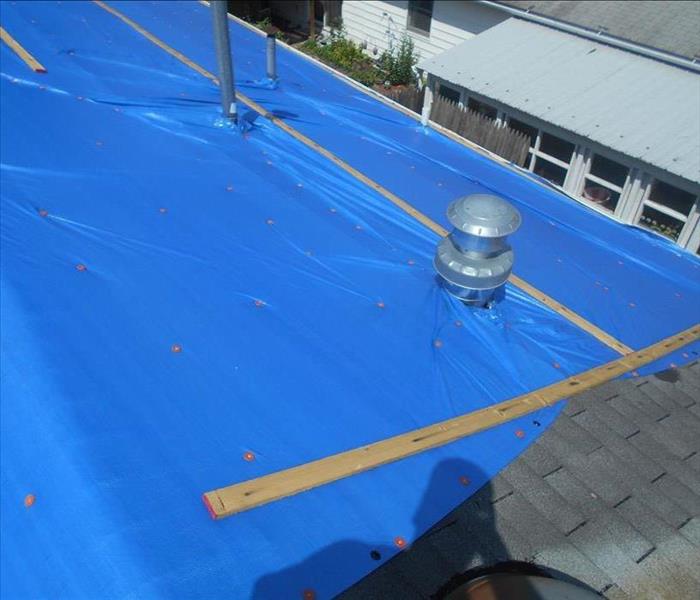 Our highly trained crews are ready to respond 24/7 to storm or flood damage in Morgantown
Our highly trained crews are ready to respond 24/7 to storm or flood damage in Morgantown
SERVPRO of Morgantown specializes in storm and flood damage restoration. Our crews are highly trained and we use specialized equipment to restore your property to its pre-storm condition.
Faster Response
Since we are locally owned and operated, we are able to respond quicker with the right resources, which is extremely important. A fast response lessens the damage, limits further damage, and reduces the restoration cost.
Resources to Handle Floods and Storms
When storms hit Morgantown, we can scale our resources to handle a large storm or flooding disaster. We can access equipment and personnel from a network of 1,650 Franchises across the country and elite Disaster Recovery Teams [SERVPRO'S Disaster Recovery Team] that are strategically located throughout the United States.
Have Storm or Flood Damage? Call Us Today at (304) 291-3434





 24/7 Emergency Service
24/7 Emergency Service









